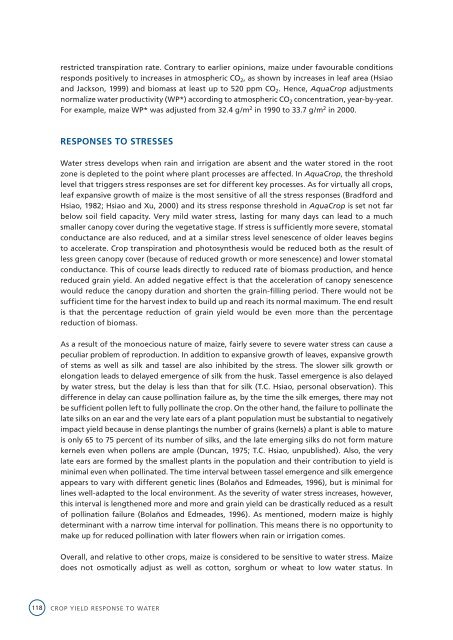Crop yield response to water - Cra
Crop yield response to water - Cra
Crop yield response to water - Cra
You also want an ePaper? Increase the reach of your titles
YUMPU automatically turns print PDFs into web optimized ePapers that Google loves.
estricted transpiration rate. Contrary <strong>to</strong> earlier opinions, maize under favourable conditionsresponds positively <strong>to</strong> increases in atmospheric CO 2 , as shown by increases in leaf area (Hsiaoand Jackson, 1999) and biomass at least up <strong>to</strong> 520 ppm CO 2 . Hence, Aqua<strong>Crop</strong> adjustmentsnormalize <strong>water</strong> productivity (WP*) according <strong>to</strong> atmospheric CO 2 concentration, year‐by‐year.For example, maize WP* was adjusted from 32.4 g/m 2 in 1990 <strong>to</strong> 33.7 g/m 2 in 2000.Responses <strong>to</strong> StressesWater stress develops when rain and irrigation are absent and the <strong>water</strong> s<strong>to</strong>red in the rootzone is depleted <strong>to</strong> the point where plant processes are affected. In Aqua<strong>Crop</strong>, the thresholdlevel that triggers stress <strong>response</strong>s are set for different key processes. As for virtually all crops,leaf expansive growth of maize is the most sensitive of all the stress <strong>response</strong>s (Bradford andHsiao, 1982; Hsiao and Xu, 2000) and its stress <strong>response</strong> threshold in Aqua<strong>Crop</strong> is set not farbelow soil field capacity. Very mild <strong>water</strong> stress, lasting for many days can lead <strong>to</strong> a muchsmaller canopy cover during the vegetative stage. If stress is sufficiently more severe, s<strong>to</strong>matalconductance are also reduced, and at a similar stress level senescence of older leaves begins<strong>to</strong> accelerate. <strong>Crop</strong> transpiration and pho<strong>to</strong>synthesis would be reduced both as the result ofless green canopy cover (because of reduced growth or more senescence) and lower s<strong>to</strong>matalconductance. This of course leads directly <strong>to</strong> reduced rate of biomass production, and hencereduced grain <strong>yield</strong>. An added negative effect is that the acceleration of canopy senescencewould reduce the canopy duration and shorten the grain-filling period. There would not besufficient time for the harvest index <strong>to</strong> build up and reach its normal maximum. The end resultis that the percentage reduction of grain <strong>yield</strong> would be even more than the percentagereduction of biomass.As a result of the monoecious nature of maize, fairly severe <strong>to</strong> severe <strong>water</strong> stress can cause apeculiar problem of reproduction. In addition <strong>to</strong> expansive growth of leaves, expansive growthof stems as well as silk and tassel are also inhibited by the stress. The slower silk growth orelongation leads <strong>to</strong> delayed emergence of silk from the husk. Tassel emergence is also delayedby <strong>water</strong> stress, but the delay is less than that for silk (T.C. Hsiao, personal observation). Thisdifference in delay can cause pollination failure as, by the time the silk emerges, there may notbe sufficient pollen left <strong>to</strong> fully pollinate the crop. On the other hand, the failure <strong>to</strong> pollinate thelate silks on an ear and the very late ears of a plant population must be substantial <strong>to</strong> negativelyimpact <strong>yield</strong> because in dense plantings the number of grains (kernels) a plant is able <strong>to</strong> matureis only 65 <strong>to</strong> 75 percent of its number of silks, and the late emerging silks do not form maturekernels even when pollens are ample (Duncan, 1975; T.C. Hsiao, unpublished). Also, the verylate ears are formed by the smallest plants in the population and their contribution <strong>to</strong> <strong>yield</strong> isminimal even when pollinated. The time interval between tassel emergence and silk emergenceappears <strong>to</strong> vary with different genetic lines (Bolaños and Edmeades, 1996), but is minimal forlines well-adapted <strong>to</strong> the local environment. As the severity of <strong>water</strong> stress increases, however,this interval is lengthened more and more and grain <strong>yield</strong> can be drastically reduced as a resul<strong>to</strong>f pollination failure (Bolaños and Edmeades, 1996). As mentioned, modern maize is highlydeterminant with a narrow time interval for pollination. This means there is no opportunity <strong>to</strong>make up for reduced pollination with later flowers when rain or irrigation comes.Overall, and relative <strong>to</strong> other crops, maize is considered <strong>to</strong> be sensitive <strong>to</strong> <strong>water</strong> stress. Maizedoes not osmotically adjust as well as cot<strong>to</strong>n, sorghum or wheat <strong>to</strong> low <strong>water</strong> status. In118crop <strong>yield</strong> <strong>response</strong> <strong>to</strong> <strong>water</strong>
















